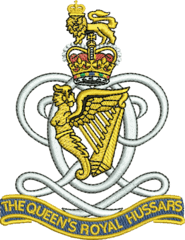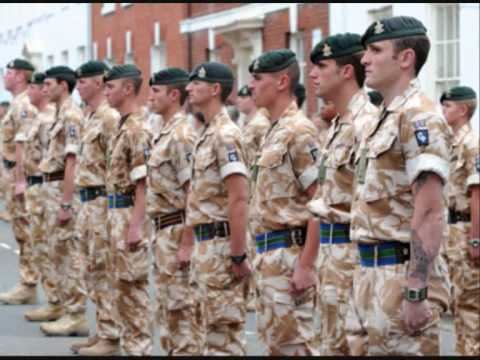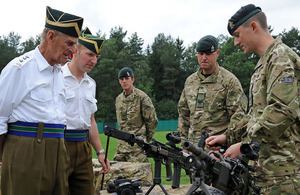Active 2 September 1993- Branch British Army Size One regiment | Type Line Cavalry Mascot Drum Horse (Alamein) | |
 | ||
Motto Mente et Manu, translated as "mind and hand" Similar King's Royal Hussars, Queen's Royal Irish Hussars, Queen's Own Hussars, Queen's Royal Lancers, Royal Wessex Yeomanry | ||
Light cavalry overture galloping 8th hussars quick march of the queen s royal hussars
The Queen's Royal Hussars (The Queen's Own and Royal Irish) (QRH) is the senior United Kingdom armoured regiment. It was formed on 1 September 1993 from the amalgamation of the Queen's Own Hussars and the Queen's Royal Irish Hussars. The regiment traces its roots back to 1685 and during the past 320 years has been awarded 172 Battle Honours and eight Victoria Crosses. The regiment is currently based in Sennelager, Germany, where it is the armoured regiment for 20th Armoured Brigade, part of British Forces Germany.
Contents
- Light cavalry overture galloping 8th hussars quick march of the queen s royal hussars
- The queen s royal hussars regimental band fallingbostel germany 27 04 1994
- History
- Victoria Cross
- Organization
- Museums
- The Regimental Crest Cap Badge
- Privileges traditions
- The Regimental Pipes and Drums
- Regimental days
- Alliances
- Affiliated Yeomanry
- References

The queen s royal hussars regimental band fallingbostel germany 27 04 1994
History

The Queen's Royal Hussars was formed in Fallingbostel on 1 September 1993 from the amalgamation of the Queen's Own Hussars and the Queen's Royal Irish Hussars.

The Queen's Own Hussars, normally referred to by the abbreviation QOH, was a cavalry regiment of the British Army, formed from the amalgamation of 3rd The King's Own Hussars and the 7th Queen's Own Hussars at Candahar Barracks, Tidworth in 1958.
The Queen's Royal Irish Hussars, abbreviated as QRIH, was a cavalry regiment of the British Army formed from the amalgamation of the 4th Queen's Own Hussars and the 8th King's Royal Irish Hussars in Hohne, West Germany in 1958.
The regiment, in January 1996, became the first to be deployed in Challenger 1 tanks to Bosnia with NATO's British-led Implementation Force IFOR. In August 1996 the regiment deployed to Northern Ireland on Operation Banner and then moved to Athlone Barracks at Sennelager as armoured regiment for 20th Armoured Brigade in January 1998. An independent tank squadron deployed to Kosovo in 2001, with the rest of the regiment deploying later that year in the dismounted role.
December 2003 saw the regiment deploy once again, this time to Iraq on Operation Telic 3. The regiment saw its first Military Cross awarded to Lance corporal Christopher Balmforth of B Squadron for his actions during an ambush in Basra.
April 2006 saw the regiment deploy once again to Iraq on Operation Telic 8 and December 2008 saw the regiment deployed to Iraq on Operation Telic 13. As the final Operation Telic the Queen's Royal Hussars were intimately involved in the drawdown from the main British base and spent many hours escorting convoys to and from Kuwait.
In 2011 the regiment deployed on Operation Herrick 15 as a ground holding Battle Group to Afghanistan in the infantry role: they worked with the Afghan National Police handing over control of checkpoints.
On return from Afghanistan in 2012 the regiment was called on at very short notice to support the Security for the London Olympic Games. The remainder of the year was used to return to the armoured role. 2013 saw C Squadron training with 5 Rifles on Exercise Baverian Charger, mounted on Challenger 2. The Queen's Royal Hussars Battlegroup, comprising sub-units from 5 Rifles and 1 PWRR deployed on Exercise Prairie Thunder 2 between July and August 2013.
In June 2014, the regiment deployed C Squadron to Operation Herrick 20 in Afghanistan, as the Warthog Group. This role involved crewing Warthog armoured tracked vehicles and operating with dismounted infantry from 5 RIFLES to disrupt insurgents in Helmand during the draw down of British troops from Camp Bastion. They were the last British combat units on the ground in Helmand.
The regiment will move to Tidworth with 20 Armoured Infantry Brigade, forming the senior of three Type 56 heavy armoured regiments of British Army's Reactive Force.
Victoria Cross
Holders of the Victoria Cross included:
Organization
The regiment is equipped with 56 Challenger 2 tanks. In addition the Regiment also fields a squadron with a close reconnaissance troop mounted in eight FV107 Scimitars.
Museums
The regiment has three museums:
The Regimental Crest & Cap Badge
The crest and cap badge are as follows:
Privileges & traditions
In over 300 years of distinguished service the regiment has gained a number of unique privileges and traditions.
The Loyal Toast: After the Jacobite rebellion in 1745, all officers of the army were required to drink the health of the Sovereign in their mess after dinner as a token of loyalty to the King. The King, however, absolved the regiment from this duty, saying that their loyalty had always been beyond question, and gave the officers the privilege of never drinking the Loyal Toast in the Officers' Mess and of ignoring the National Anthem (they remain seated) when it is played by the band after dinner. This privilege was reaffirmed by the Sovereign prior to the formation of the regiment in 1993.
The White Horse of Hanover: Ranking second, after the Crown, among the regiment's military badges, it was bestowed by the first three King Georges to certain regiments for their part in suppressing the Jacobites. It was first granted, as a special head-dress badge, by King George I to the 3rd King's Own Regiment of Dragoons in 1715 for their part in defeating James Francis Edward Stuart (The Old Pretender).
Crossbelts: At the Battle of Almenar in 1710 the 8th Dragoons pursued the Spanish Cavalry Corps and, equipping themselves with the crossbelts of the enemy, cut down the Spaniards with their own swords. The crossbelts were worn with distinction for many years, and the nickname 'St Georges Crossbelts' was given to the regiment. Although the crossbelt worn today is based on the original 4th Hussar pattern, the continuing tradition of titling the Regimental Journal 'The Crossbelts' is in recognition of this famous action.
The Maid of Warsaw: Every member of the regiment wears the Maid of Warsaw, the crest of the City of Warsaw, on the left sleeve of his No. 2 (Service) Dress. This honour was awarded to the 7th Hussars by the Commander of the Second Polish Corps in recognition of their valour in support of the Polish Forces during the Italian Campaign in World War II. Traditionally the original crest presented to the regiment is placed in front of the Commanding Officer on Dinner Nights.
The Fern Leaf: All vehicles in the regiment display the emblem of New Zealand, the Fern Leaf, to commemorate the association of the 3rd Hussars with the 2nd New Zealand Division at the Battle of El Alamein where the regiment lost all but five tanks breaching the German line. This honour was granted by General Lord Freyberg VC.
Kettle Drums: By command of King George II the silver kettle drums captured by The King's Own Regiment of Dragoons, later the 3rd Hussars, at Dettingen are borne by a drum horse ridden by a Sergeant Kettledrummer - both being additional to the regimental establishment. The drums are always carried at the head of the regiment on ceremonial parades and are, uniquely amongst cavalry regiments, never covered by drum banners, the battle honours being engraved directly onto the sides of the drums. In 1772 when Lord Southampton commanded the regiment, his wife gave a silver collar to be worn by the Kettledrummer, which is still worn today when parading in full dress with the drums. The present drum horse is named Alamein and its nickname is Dudley.
Winston Churchill: Winston Churchill, who has been described as 'the greatest Hussar of them all', was commissioned into the 4th Hussars in 1895, and later became the Colonel-in-Chief of the regiment from 1941, until the 4th Queen's Own Hussars was amalgamated with the 8th Hussars in 1958, after which he became Colonel-in-Chief of the new regiment, Queen's Own Royal Irish Hussars remaining so until his death in 1965. In recognition of this, The Churchill Cup is awarded to the top-scoring troop in the regiment's annual gunnery competition. The Commanding Officer's tank is also named 'Churchill'.
The colours are as follows:
The lyrics of the song go:
I'm a soldier in the Queen's Army.
I'm a galloping Queen's Hussar.
I've sailed the ocean wide and blue.
I'm a chap who knows a thing or two.
Been in many a tight corner.
Shown the enemy who we are.
I can ride a horse.
Go on a spree, or sing a comic song.
And that denotes a Queen's Hussar.
The Regimental Pipes and Drums
The Pipes and Drums were inherited from the Queen's Royal Irish Hussars. There has been no formal adoption of pipe music by the regiment, but the pipe tunes have become very much a part of Regimental Parades, the following tunes have become part of the Regiment's Music.
Regimental days
The following are celebrated as battle honour days:
St Patrick's Day is also celebrated.
Alliances
Commonwealth
Non-Commonwealth
